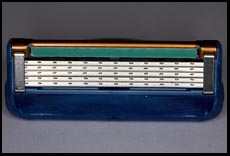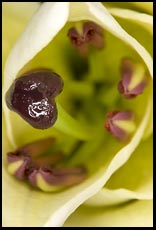
Canon EF 100/2.8 Macro USM Lens Review
by Philip Greenspun; created February 2008
Site Home : Photography : EF 100/2.8 Macro USM

by Philip Greenspun; created February 2008
Site Home : Photography : EF 100/2.8 Macro USM
A 100mm macro lens has long been the standard for photographers using full-frame cameras. The magnification of the 100mm lens provides sufficient working distance from most subjects and does not add a lot of weight or bulk compared to shorter macro lenses.
This is an extremely sharp portrait lens that focuses down to 1:1, i.e., you can photograph an object as small as the 24x36mm sensor in a full-frame camera or the 15x23mm sensor in a Digital Rebel. The front element of the lens will be about six inches from the subject when focussed down to 1:1.
The Canon 100/2.8 Macro USM is still available as of 2018, but has been superseded by a slightly more expensive and presumably higher quality 100/2.8L version.

The lens design is of medium complexity, with 12 elements of glass arranged in 8 groups. The same arrangement of glass that produces sharp images at infinity will not produce optimum results focussed close. Consequently, three of the 12 elements are in a "floating group" that moves as the focus is adjusted, i.e., the optical formula of the lens changes as the lens is focussed from infinity down to 1:1.

Focus is via an ultrasonic motor, which provides for very fast autofocus and full-time manual focus. The lens includes a switch to limit the autofocus range to 0.5 meters so as to avoid slow back-and-forth hunting with non-macro scenes. More unusually, the focus mechanism is entirely internal. The front filter does not rotate and the lens does not extend, even when going from infinity all the way out to 1:1.
The lens takes 58mm filters and a very deep ET-67 circular hood that bayonets on to the outside. For easy removal and reinstallation of the lens cap with the hood in place, it is best to get a lens cap with center releases, such as the Tamron (available from B&H Photo). A tripod collar, denoted "Tripod Mount Ring B", is sold separately, but should not be necessary with the beefier Canon bodies.
Weight is 21 oz. or 600g.
The young photographer asks the veteran for advice on how to take pictures. "f/8 and be there," is the standard answer, but it isn't a very good one for a 100mm macro lens. Depth of field at 1:1 magnification at f/8 is about 1mm, i.e., not sufficient unless the subject is flat and the lens is precisely orthogonal to the subject plane.

|
Image at left: f/8 Image at right: f/16 |

|
For most practical macro purposes, life starts at f/11 and gets smaller from there. Here is the same subject at f/11, f/22, and f/32. Notice how the tail and wingtips of the airplane come into progressively sharper focus. Depth of field at f/32 should be approximately 4mm, still not much, but viewers of macro images are accustomed to selective focus.
If good depth of field is the goal, why not set the lens to its minimum aperture of f/32, use a big strobe or tripod and long exposure time, and get as much depth of field as possible? Diffraction. Photographing objects through a tiny hole, such as a lens's minimum aperture, creates a somewhat fuzzy image due to diffraction.
Why mention diffraction in a review of this specific lens? Diffraction is a more serious problem with macro photography than with general purpose photography. With macro, one is more likely to require very small apertures to obtain sufficient depth of field. What's worse, at high magnifications, the effective aperture becomes ever smaller. For example, at 1:1, the 100/2.8 Macro USM might be set to f/32 but in terms of the amount of light transmitted and the diffraction, it is functioning as though it were set two f-stops smaller, i.e., f/64.
What's wrong with f/64? A lot of 8x10" view camera photographers use f/64! Keep in mind that the 8x10" view camera photographer is likely using a 300mm lens and that f-stops are ratios. An f/64 aperture on a 300mm is much wider than an f/64 aperture on a 100mm lens.
Here is some printed text at f/11, f/16, f/22, and f/32. The magnification was 1:1 and light was from a Canon MR-14EX ring light. Click to get larger versions so that you can see how the text becomes fuzzier and lower contrast at f/32.
Sure. Get a light tent, a couple of EX strobes and a wireless controller, and you're all set. Here are a couple of examples taken with just a simple Canon macro flash:
A 100mm lens set to f/2.8 sounds more or less ideal for portraits. Does that make the 100/2.8 Macro USM a great portrait lens? Not quite. For its popular portrait lenses, e.g., the 85/1.2, 85/1.8, 100/2, and 135/2, Canon puts a lot of effort into making the background blur ("bokeh") pleasing. This lens is not going to render out-of-focus highlights as smoothly as a lens specifically designed for portraits. Nor is the extra sharpness of this optic necessarily welcome by subjects, unless the goal is a reference image prior to dermatological surgery.
On an APS-C (crop sensor) body, this lens works the same as a 160/2.8 macro lens would on a full-frame camera, with the exception of more depth of field for any given aperture. For taking photographs of skittish insects, this would be an excellent choice on a small sensor body.
The most useful accessory for this lens is a Canon macro flash.
The superb Canon 60mm macro on a small sensor body, such as one from the Digital Rebel series, produces the same working distance and magnification as the 100/2.8 on a full frame body.
On a full-frame body, here are the main alternatives:
Sigma, Tamron, and Tokina all make fixed focal length macro lenses in the 90-105mm range. Optically these are very high quality, but they aren't significantly cheaper than Canon's.
Canon delivers everything that a photographer could want in a 100mm macro lens: ultrasonic focus motor, internal focus mechanism, non-rotating front element, floating optical group for consistent image quality at different magnifications, rugged construction, and reasonable price.

|
Two sides of a medal depicting some of the buildings of Rome. The
medal is 2.75" in diameter. View the
100 percent JPEG (3786x5651 pixels) to see the detail. Both
images exposed at f/11 with the |

|
Text and pictures copyright 2008 Philip
Greenspun. Unless otherwise noted, all images on this page were taken with a
full-frame